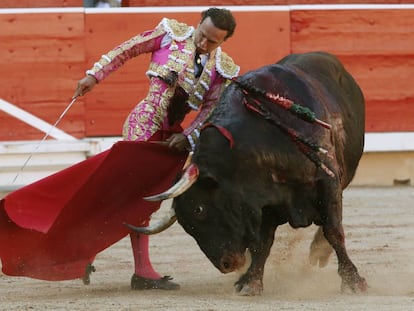Sanfermines in numbers: 10 facts you need to know
EL PAÍS looks at the staggering figures behind Pamplona’s world-famous bull-running fiestas

The Sanfermines fiestas kick off on July 6 with the much-anticipated “Chupinazo” ceremony, which sees the launching of a rocket to mark the start of the event, which will run until July 14. For the first time this year, authorities in Pamplona have banned the sale of souvenirs with sexist messages in an effort to create a “festival free of sexual abuses.”
The San Fermín fiestas continue to be a major crowd-puller, with more than 1.45 million people attending last year’s fiestas, which included 425 different activities.
But that’s not the only impressive figure. Ahead of the landmark celebrations, EL PAÍS has crunched the numbers to show the scope and impact of Spain’s most popular taurine event.

Reports of sexual abuse in 2017
According to a study by the Public University of Navarre, 22 reports of sexual abuse were filed last year. This number has increased significantly. In 2006 and 2007, there were no reports of sexual harassment.

Millions of euros in investment
Pamplona City Hall has allotted 6% more funding to this year’s festival than last. The total amount is over €2.24 million, taking into account the money needed to hire extra staff and rent portable bathrooms.

Officers in the streets
Nearly 3,000 police officers will be patrolling the streets at the Sanfermines celebrations. The strong police presence is made up of officers from the Civil Guard (796), National Police (950), regional police (720) and local police (400).

The first year of the ‘Chupinazo’
This was the first year a rocket was launched to mark the opening of the Sanfermines fiestas. The tradition is known as the ‘Chupinazo,’ a name coined by Txupin Etxepare, a tobacconist from Pamplona. The custom continued up until 1936, the year the Spanish Civil War began and the same year Etxepare was killed. The tradition was brought back in 1939.

Posts on the running route
Along the route of the run, which is 848.6 meters long, are almost 1,000 posts, 2,700 wooden boards and 4,000 wedges that separate the track from the rest of the city. There are 70 doors that provide an escape from the route, and six more that are progressively closed behind the bulls as the run gets underway to prevent them from turning back.

Promotional posters
Every year, Pamplona City Hall holds a competition for the best Sanfermines promotional poster. This year the winning design was entitled Pamplona, city of lights, and received 33% of the vote: 2,200 of the 6,511 votes. Fewer designs were submitted this year compared to the last two. There were 327 national entries and five from other countries.

Miura bull runs
The Miura line of Spanish fighting bulls has taken part in more runs at Sanfermines than any other bull breed. Miura bulls have left 16 people with goring injuries and another 184 with bruises. On Saturday, July 14, the breed will be ready to once again run the streets of Pamplona.

Longest Sanfermines bull run
The record for the longest Sanfermines bull run is 30 minutes. It took place on July 11, 1959 when a Miura bull lagged behind the herd. Authorities needed to get a dog to bite the bull to force it into the pen.

Number of times Sanfermines has been canceled
Sanfermines has only ever been canceled for political reasons. This happened in 1937 and 1938 during the Spanish Civil War. It was canceled a third time in 1978, when a student died after being shot in the head in clashes between police and protesters, and in 1997 when politician Miguel Ángel Blanco was murdered by Basque terror group ETA.

Deaths since 1910
Of the 16 people who have died at Sanfermines, two have been foreigners – a Mexican who was killed in 1935 and an American who lost his life in 1995. The most recent death took place on July 10, 2009 when Daniel Jimeno Romero was gored in the neck.
English version by John Clarke.
Tu suscripción se está usando en otro dispositivo
¿Quieres añadir otro usuario a tu suscripción?
Si continúas leyendo en este dispositivo, no se podrá leer en el otro.
FlechaTu suscripción se está usando en otro dispositivo y solo puedes acceder a EL PAÍS desde un dispositivo a la vez.
Si quieres compartir tu cuenta, cambia tu suscripción a la modalidad Premium, así podrás añadir otro usuario. Cada uno accederá con su propia cuenta de email, lo que os permitirá personalizar vuestra experiencia en EL PAÍS.
¿Tienes una suscripción de empresa? Accede aquí para contratar más cuentas.
En el caso de no saber quién está usando tu cuenta, te recomendamos cambiar tu contraseña aquí.
Si decides continuar compartiendo tu cuenta, este mensaje se mostrará en tu dispositivo y en el de la otra persona que está usando tu cuenta de forma indefinida, afectando a tu experiencia de lectura. Puedes consultar aquí los términos y condiciones de la suscripción digital.
More information
Archived In
Últimas noticias
How Japan is trying to avert ‘digital defeat’
From digital curfews to blocking apps: How technology experts protect their children online
Why the price of coffee has skyrocketed: from Brazilian plantations to specialty coffee houses
Confined to a Cuban hospital: When electricity is a matter of life or death
Most viewed
- Pablo Escobar’s hippos: A serious environmental problem, 40 years on
- Reinhard Genzel, Nobel laureate in physics: ‘One-minute videos will never give you the truth’
- Why we lost the habit of sleeping in two segments and how that changed our sense of time
- Charles Dubouloz, mountaineering star, retires at 36 with a farewell tour inspired by Walter Bonatti
- The Florida Keys tourist paradise is besieged by immigration agents: ‘We’ve never seen anything like this’











































